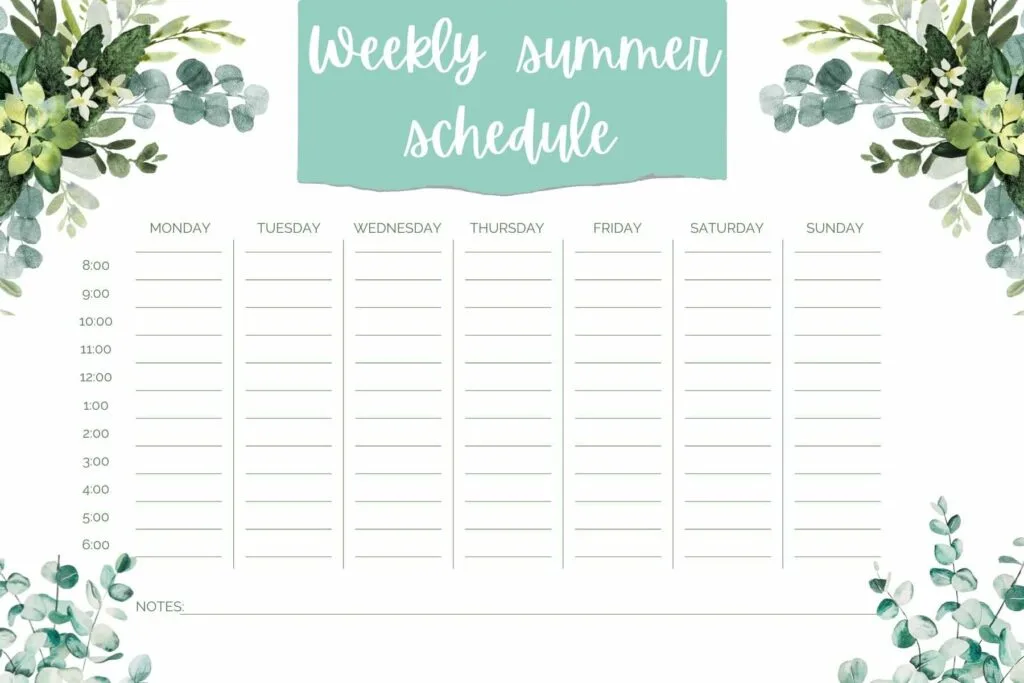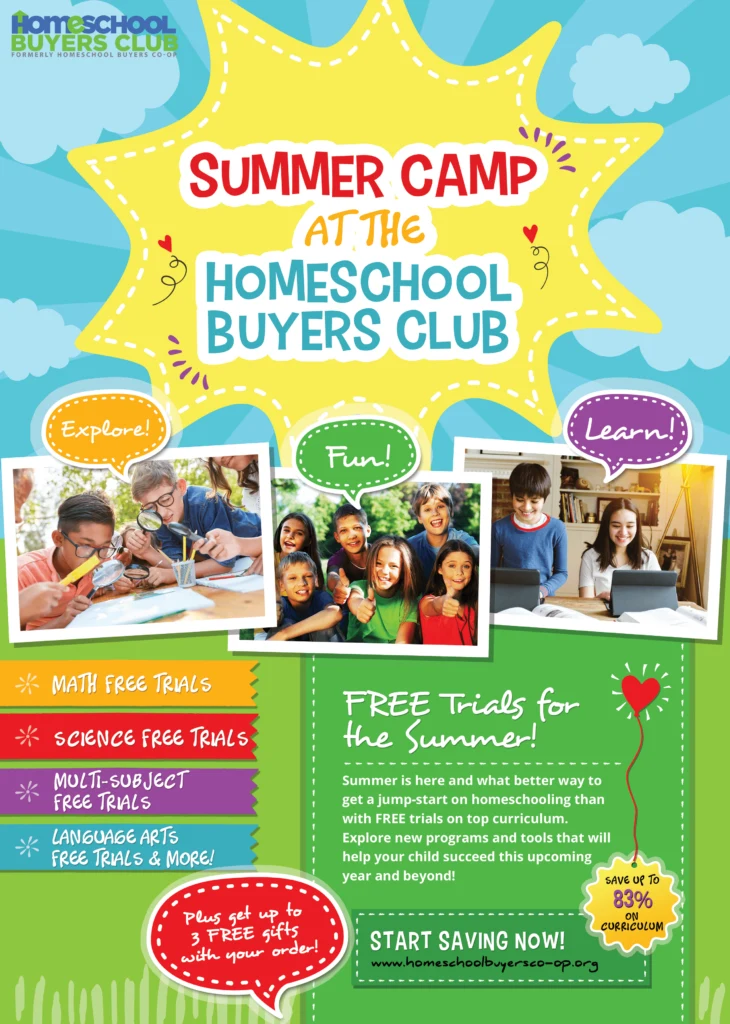Looking for ways to keep the kids entertained this summer while preventing learning loss? Why not put together a simple summer homeschool curriculum? The summer months are the perfect time to explore new interests, strengthen skills taught during the previous year, and test out programs you might want to incorporate in the next school year.
With a relaxed homeschool summer schedule and free resources from sites like the Homeschool Buyers Club, your homeschooling family can cultivate new skills without missing out on all the usual thrills of summer. Check out our top summer homeschool ideas below.

I was compensated for my time reviewing the Homeschool Buyers Club. All opinions are my own and I am not required to post a positive review.
Affiliate disclosure: This post may contain affiliate links, which means we may receive a commission if you click a link and purchase something that we have recommended. Please read our disclaimer for more details.
Summer School? What Happened to Summer Break?
Homeschool kids (and their parents) wait for it all year—that last day of “school” when we are done with all our classes, co-ops, and curriculum. The last page of the math book is complete, recitals are in the bag, and end-of-year picnics have been attended.
We can all breathe a collective sigh of relief and celebrate a job well done—though if we’re being honest, most times we’ll just as happily settle for done—and mark the beginning of our summer freedom with a trip to the waterpark.

With two glorious months spread wide in front of us, we don’t want to think about things like curriculum, lesson plans, and equations until the middle of August at the very soonest (assuming a post-Labor Day resumption of formal activities).
Trust me, I get it. My kids officially finish tomorrow and I am standing by, ready to whip out that summer bucket list and hit the U-pick berry farm.
But there’s also a part of me that knows the danger in setting aside all of our hard-won routines and habits for the whole summer. Summer learning loss, also known as the summer slide, is a real thing. That’s why most math curricula spend the first month or two of the new school year reviewing the things taught the previous year. Two months without practice leaves us rusty at any skill, especially one that we’d only just scratched the surface of.
However, that’s not to say that you need to spend the whole summer vacation reviewing the quadratic formula or brushing up on the periodic table.
You can maintain a relaxed schedule over the summer with plenty of time for seasonal fun while still incorporating a few strategic summer activities to keep your kids’ skills strong.
Here are a few reasons homeschool families might want to include learning activities in their summer schedule.
Maintain Routine
A good routine takes a lot of work to establish. Once you have one, you want to hold onto it.
While summer days do offer us the freedom of sleeping in and eschewing a daily schedule, it’s not necessarily in our best interest to do so. The further we stray from our regular school year routine over the summer, the harder it is to get back to it in the fall. By maintaining some semblance of a routine over the summer, we send a signal to our kids’ brains—and our own—that they need to remember the rhythms we worked so hard to develop over the past year.

Strengthen Skills
Those fresh skills your kids just developed are like seedlings. If left untended for two months, they’re going to wither.
By finding fun ways to reinforce those skills over the summer, we can make sure they’ve grown roots by the start of the upcoming school year.
Whether that means taking music lessons over the summer, completing a few STEM unit studies, or following a summer reading program, the important thing is that we keep building the new connections forming between their synapses.
Try New Things
Trying new things during the typical homeschool year poses a number of problems. First, many programs require a year-long commitment. If you are one month in and your child decides they hate it, you may face financial consequences of pulling them out early. Not only that but the financial commitment of a year-long program is a lot higher in the first place than something you merely dabble in over the summer.
Second, competing interests force you to choose only a handful of activities. Let’s say your child wants to take both theatre and an in-person social studies class, but they take place at the same time on Thursdays. The choice requires weighing several variables, such as which will benefit them most, what alternatives are available, how much each program costs, and what the requirements of their grade are. Using the summer months to take an online course or fill a curricular requirement is a great way to fit in more of the things your child loves to do.
Limit Screen Time and Boredom
A lack of activity often leads to boredom, and the first thing many kids turn to in times of boredom is their screens.
This is not new. I distinctly remember hitting up the video store multiple times a week as a teen and taking advantage of their 5 movies-5 days-5 dollars deal. My friends and I would watch two or three movies and then spend the rest of the day swimming at the lake. They weren’t the most productive months of my life, but we certainly had a great time and made some fun memories.
Screen time these days is not always as passive as watching an old Steve Martin film. Kids are more likely to be on YouTube or TikTok watching who knows what or getting sucked into social media and its confidence-shattering culture.
Simple things like DIY summer camps and a recommended reading list offer creative ways for both young children and older kids to stave off boredom.
Setting Up a Daily Summer Schedule
If you’re ready to start planning a light summer homeschool schedule, I have lots of great tips on how to schedule both school work and free time.
As I recently wrote about in this article for Joyful Life Magazine, setting up a summer schedule for kids helps manage expectations and ensures that you have enough time for both learning and fun—not that those are mutually exclusive.

I recommend breaking the day down into blocks of time, which could be anywhere from fifteen minutes to a few hours long. Examples of some blocks you might want to include in your schedule are:
- Morning time. Morning is usually a good time for kids to do the things they have to do. Chores, individual courses, personal hygiene, and a simple fitness routine can all be done in the first few hours of the day to kick things off to a good start.
- Structured learning time. If you plan to do online courses, unit studies, workbooks, or projects together, make sure to leave a certain number of minutes per day to make progress on those goals. Depending on the age(s) of your kid(s), this could be as little as half an hour or as much as two to three hours (for a teen taking one or more full-credit online classes over the summer, for example).
- Quiet time. I like to include a short quiet time each day for everyone—especially this weary homeschool mom—to recharge. We usually do this right after lunch.
- Reading time. In our house, most of us gravitate toward a good book whenever we have a moment of downtime, so we don’t necessarily put this on our schedule. But if it’s a habit you’re still working to develop, definitely set aside extra time for independent reading. Keep your home stocked with great books by making frequent trips to your local public libraries and delight in them individually and as a family.
- Independent play time. Give kids time to play independently each day. Many activities they choose have natural educational value, and you don’t need to force the teachable moment on them. Just let them have fun. (In our home, independent play ranges from building with Lego and making forts in the backyard to writing songs and reorganizing and decorating the living room).
- Outside time. Depending on where you live, summer might be the only month where spending lots of time outdoors is enjoyable. If your region is like that, by all means, get outside as much as possible. Even if it means taking your times table flash cards to the front yard to build some math skills, get in all the fresh air you can. (And if you live in one of those super hot places where going outside in the summer is unbearable, what better time to hunker down in your air-conditioned kitchen or at your local library and work on some literacy skills?)
- Field trips. Despite our best intentions, we take far fewer field trips during the rest of the school than I’d like. There simply isn’t enough time. But with the right relaxed homeschool schedule, there’s plenty of time to fit in excursions to museums, art galleries, historical sites, national parks, and local tourist hot spots. Try to plan your trips during low-volume periods such as early mornings on weekdays in order to avoid the crowds as much as possible.

Free Summer Homeschool Curriculum
Finally, I want to share some ideas on where to find the best free summer resources. After all, we spend so much money on curriculum during the homeschool year. The last thing we need is to dole out hundreds of dollars on an additional summer homeschool curriculum.
The Homeschool Buyers Club is becoming my go-to source for free homeschool resources and extended free trials of online resources. The Homeschool Buyers Club (HBC) is exactly what the name suggests—a buying club for homeschoolers. With over 300,000 members, the HBC harnesses the purchasing power of homeschool families and helps us secure the best deals on homeschool curriculum and resources. Best of all, it’s free to become a member of the HBC, so it makes sense to join even if you just check there for deals before purchasing your regular curriculum.
They also offer tons of free resources. Check out some of the cool freebies you can snag there. (All of the resources below are accessible on the free resources page unless stated otherwise).

Math
Review math facts and boost your child’s new skills with one or more of the following resources:
- Doodlemath. DoodleMaths is an app that uses the latest adaptive learning technology to create a fun, personalized work program tailored to your child’s strengths and weaknesses. The ideal homeschool math aid, Doodle fills any learning gaps and gradually introduces new concepts, boosting confidence while ensuring progression in all areas of math standards. Get a 7-day free trial and 70% off an annual subscription. Single-child and family memberships are available.
- Mathseeds. Mathseeds, a companion product to Reading Eggs (but available separately), is one of my favorite math programs for the early years. My son used this throughout pre-K and developed his math skills much faster than his older sisters, who didn’t use it. Get a 30-day free trial, and 41% off membership through the Homeschool Buyers Club.
- Creta Class. This award-winning app-based math program, based on the Singapore Math curriculum (one of my all-time favorites), helps kids cultivate math confidence along with key learning skills such as logical reasoning, problem-solving, and arithmetic. Get a 7-day free trial.
- Math Mammoth. Math Mammoth offers a full math curriculum and supplemental worktexts and workbooks available as electronic downloads or on a CD. Get three complimentary math worktexts covering grades K-3, 4-5, and 6-8 through HBC.
- See other free math resources from HBC.
Literacy
Summer is the perfect time to work on kids’ reading and writing skills because they can read and write whatever they want without the distraction of assignments getting in the way.
- Smile and Learn. Smile and Learn is an educational platform specializing in videos, games, and stories that are beautifully designed by educators in 6 languages. The platform reinforces cross-curricular learning in Math, Literacy, Foreign Languages, and Sciences along with SEL, Global Awareness, and cognitive skills development. Get a 30-day free trial.
- Reading Eggs. Reading Eggs is an immersive reading app with activities, lessons, games, songs, videos, books, rewards, and contests. I’ve used it with two of my children who both really enjoy it. Get 30 days free and up to 41% off a membership.
- Reading skills assessment. Get a free reading skills assessment from Explode the Code and identify your child’s strengths and problem areas when it comes to reading, as well as suggestions for additional practice.
- Vocabulary Quest. Master advanced vocabulary to defeat the Mages and restore order to the Lands of Vocab. Before each battle, students review a set of words by reading usage examples, listening to the audio pronunciation, and playing mini-games. Then, they battle the mages in a final fill-in-the-blank test. Get 40% off a lifetime download.
- See all reading, spelling, language, and literature resources on HBC.
Science
Science experiments are another thing I tend to skimp on during the traditional school year. I just don’t have time to collect supplies, set up and conduct the experiments, and clean up the inevitable messes that ensue. In summer, our relaxed schedule gives us time to break out the beakers and hone our hypothesis-development skills.
- Code Avengers. Code Avengers provides interactive and engaging computer science learning, making coding concepts accessible to learners of all levels. Course modules are blended with STEM and literacy learning, and broken into simple tasks that support progression. Get a 10-day free trial.
- Aquaponics bundle course. Dynamic Earth Learning provides easy access to digital science courses that keep kids and teens interested in the world around us. Engage with science and sustainability topics that extend beyond the science lessons commonly taught today. Get the whole course for free.
- Monarch. Monarch is a Christian online homeschooling curriculum for grades 3-12 that features automatic grading, complete customization, 24/7 availability, and more. Students have access to courses in 5 core subjects including Bible, History and Geography, Language Arts, Math, and Science. Get 30 days free.
- See all free science resources on HBC.
Other
- Test prep. Summer is the perfect time to prep for and take college entrance exams such as the SAT and the ACT. You can take these exams multiple times without penalty. Programs such as MathHelp.com, …. offer test prep courses.
- Mark Kistler Art Lessons. My husband grew up drawing with Mark Kistler in the 80s and 90s and my kids have learned from him as well. Get free access to seven of his 3D art lessons.
- History Alive. With topics ranging from geography to history, to science and geopolitics, every month History Alive has the ability to spark a new passion and facilitate learning in ways that might never be explored. The core curriculum is twenty, 5 minute videos covering an individual point of the overarching topic. Get 30 days free.
See all of HBC’s summer homeschool curriculum options and other free curriculum resources.
-1.png)
Finally, when you sign up for any of the above free trials from the Homeschool Buyers Club, you also get access to up to three gifts, as follows.
1. The Kids Guide to Staying Safe Online
Homeschooling parents need to make sure kids know how to protect themselves from dangerous situations that the Internet can present. This fun and free guide teaches children how to use the internet responsibly and safely.
2. A FREE issue of EverBright Kids Magazine
EverBright Kids is an at-home learning magazine that’s packed with fascinating educational content, engaging science experiments, entertaining arts and crafts, yummy recipes, and so much more.
3. A full month of unlimited access to eSpired Library
Filled with more than 25,000 books, audiobooks, videos, magazines, and more, eSpired Library empowers homeschoolers to teach whatever they want, whenever and wherever they want.
With a relaxed daily schedule and some free summer homeschool curriculum, learning and fun can be synonymous this summer. What topics are you most excited to cover with your kids over the summer months?

Sophie Agbonkhese is a writer, homeschooling mother of four, and a recovering overachiever (who occasionally relapses). She is the founder of My Cup Runs Over, a site dedicated to helping busy women simplify and enrich their lives. When she’s not writing or debugging websites, Sophie spends her time reading, dancing, bullet journaling, reading, gardening, listening to audiobooks, and striving fruitlessly to have a clean house for at least five minutes.

